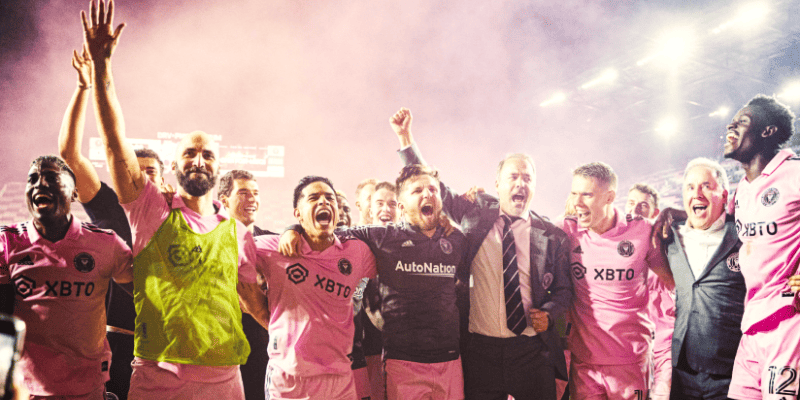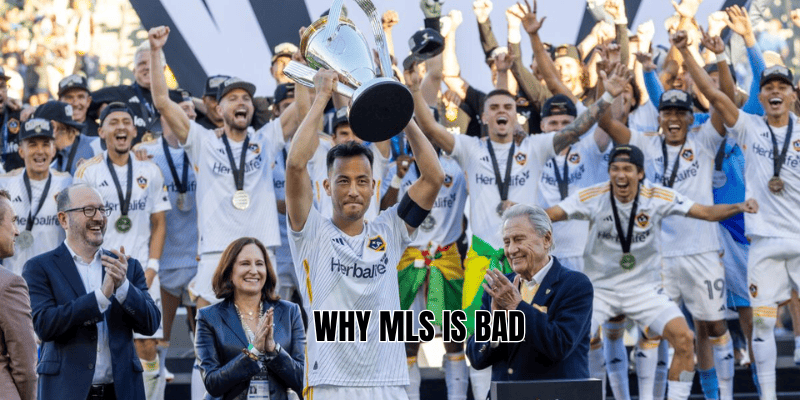Right off the bat: the question why MLS is bad has more than one answer — it mixes structural problems, cultural friction, and a gap in quality compared to top global football. CicloKick will walk you through what many critics see as MLS’s weaknesses — and why some feel it still falls short despite progress.
Key criticisms of MLS

Here are the main reasons why fans, pundits, and ex-players often say MLS is bad.
1. Salary caps and financial restrictions
- MLS uses a salary cap system which limits how much teams can spend on players. This helps competitive balance but also prevents many clubs, world-class squads with quality in every position. It’s very unlike Premier League, La Liga, or Bundesliga clubs that can invest heavily.
- While there is the Designated Player rule (which allows a few star players to be paid above the regular cap), the surrounding roster often lacks depth. One star can’t hide the weak substitutes and thin benches.
- Average salaries in MLS still lag well behind many major leagues globally. Even some second-tier European leagues can offer more for mid-level or up-and-coming players than MLS teams outside the top spenders.
2. Lack of promotion/relegation and closed league model
- MLS is a closed league (no relegation to a lower division), which means the pressure to perform is different. Teams don’t fear dropping out of the league, which weakens one of the main levers of competitiveness in world football. Fans in many countries believe relegation drives higher standards in coaching, player investment, and match intensity.
- Without promotion/relegation you avoid ruin, but you also lose the drama and consequences that push clubs to improve continuously.
3. Quality and consistency of play
- Because of financial limits, many MLS teams lack depth, meaning that consistency week to week is low. A squad can beatteam one week, then lose badly the next because backups aren’t as strong.
- Tactical development and youth development systems are still catching up. There are emerging academies and “home-grown” players, but against European or South American pipelines, MLS still has a gap. Some players move abroad to improve.
4. International competitiveness
- When MLS clubs face top international competition (e.g. in Club World Cup or against strong Latin American teams), the limitations show: squad quality, experience, and depth tend to suffer. Critics point out that besides individual stars, the supporting cast often doesn’t match those of world-class squads. Recent matches have exposed those gaps.
- Also, because of roster restrictions (salary cap, limit on foreign players, etc.), MLS clubs can struggle to compete for or keep elite young talent. They often lose players to European or other leagues when those players become good enough.
5. Disparity within the league
- Some MLS clubs spend significantly more than others. For example, Interami has one of the highest payrolls in MLS. Meanwhile, clubs like Real Salt Lake are near the bottom in spending, often $10-20 million less in guaranteed compensation than top spenders. That creates performance gaps.
- But big spending doesn’t always guarantee success. There are examples of lower-payroll clubs punching above their weight — but the disparity still frustrates fans who want more predictable standards across teams.
6. Cultural and fan perception issues
- For many global football fans, MLS is seen as “less serious” or “secondary” because it hasn’t had the long traditions, huge rivalries, or historic trophies of European/South American football. Even though attendance in some MLS matches is strong, the passion and years of lore are less.
- Also, some think MLS is viewed by certain players as a place to wind down rather than a place to push for the very highest level. That perception still lingers, even if it’s not always fair.
What MLS does well (to offer perspective)

To be balanced, it’s worth noting what MLS is doing right, because many criticisms come.
- The league has grown significantly in terms of audience, infrastructure, investment, and visibility. Big signings bring attention and raise standards (Messi is one obvious example, though stars alone don’t solve systemic issues).
- MLS has increasingly invested in home-grown talent and youth academies. More players are being developed internally, reducing reliance on imported stars.
- The Designated Player rule shows MLS is trying to balance structure with flexibility — letting clubs with ambition spend more to attract big names, while still maintaining a baseline of financial responsibility.
Why these flaws matter (for fans and for the future)

These criticisms aren’t just academic — they affect what you see on the pitch, in media, and in how seriously MLS is taken globally:
- They affect quality of matches: weaker bench depth leads to huge swings in performance, making some games less competitive.
- They limit MLS clubs’ chances in pan-international tournaments and friendlies: weaker squads tend to lose badly to more complete teams.
- They affect the transfer market: young talents see MLS as less competitive; big clubs elsewhere have more pull for those players.
- They affect global reputation: for fans wanting world-class football, it’s hard to see MLS as “top-tier” yet.
What needs to change
If MLS wants to address why many believe MLS is bad, several things could help:
- Easing salary restrictions or redesigning cap rules to allow more depth in rosters.
- Further investment in youth development and academies to produce more home-grown stars.
- Possibly exploring a promotion/relegation model.
- Better alignment with international standards: in coaching, infrastructure, scouting, etc.
- More parity in revenue, broadcasting, and player compensation across clubs, to reduce disparity but keep growth momentum.
Conclusion
MLS is bad is a strong phrase — but there are reasonable arguments behind it. The league has structural limitations (salary caps, closed membership, disparity in club spending), a gap in consistency and squad depth with global powers, and a reputation issue. On the flip side, MLS is growing, changing, investing, and producing results that show promise for the future.
If you’re tired of frustrating inconsistency or want MLS to reach its full potential, the road forward is clear: reform financial rules, improve development systems, close the gap internationally. CicloKick invites you to stick around: read our transfer analyses, player interviews, and comparisons as we watch MLS evolve. Ask questions, challenge assumptions — let’s see if MLS can rise up in your eyes.






